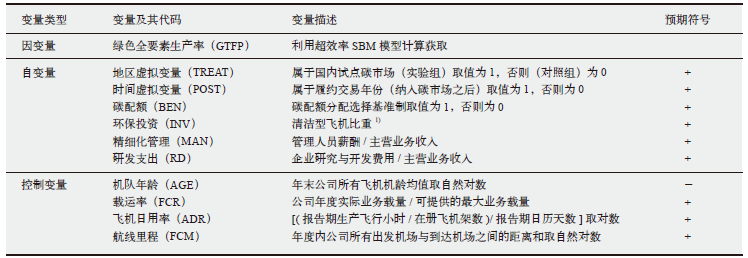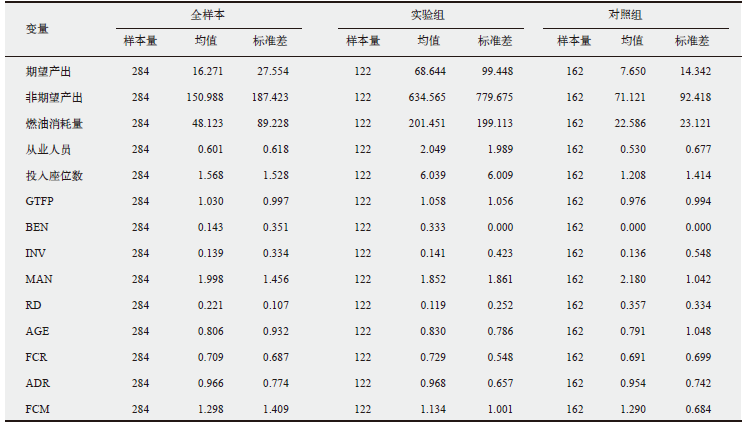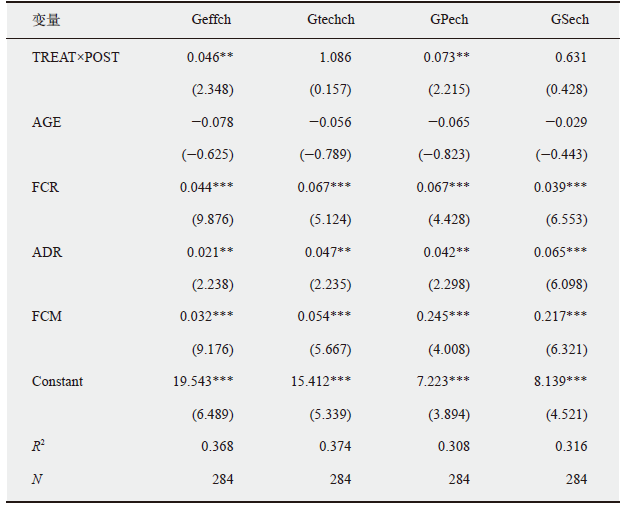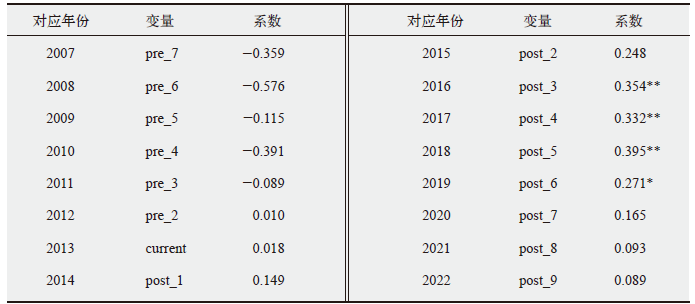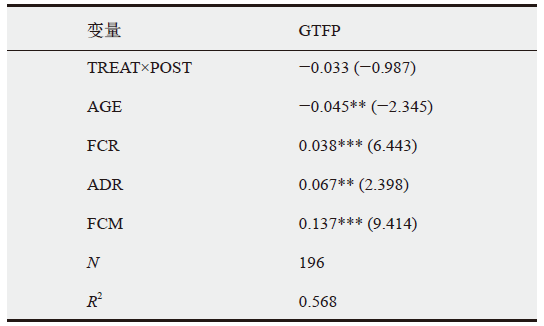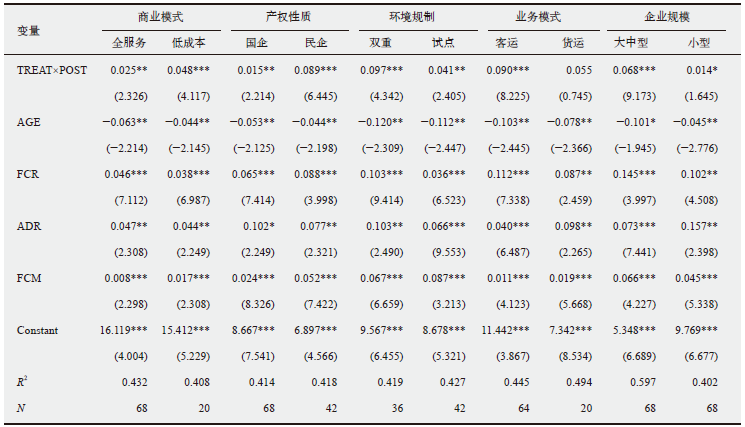气候变化研究进展 ›› 2023, Vol. 19 ›› Issue (3): 320-333.doi: 10.12006/j.issn.1673-1719.2022.182
“双碳”目标下ETS与航空公司绿色全要素生产率
- 1 中国民航大学环境与可持续发展研究院,天津 300300
2 中国民航大学经济与管理学院,天津 300300
3 中国民航大学交通科学与工程学院,天津 300300
-
收稿日期:2022-08-02修回日期:2022-12-26出版日期:2023-05-30发布日期:2023-05-19 -
作者简介:田利军,男,教授,tljshenji@126.com -
基金资助:天津市教委社会科学重大项目“碳中和目标下天津民航绿色低碳发展路径研究”(2021JWZD39)
Research on the impact of carbon emissions trading scheme on airlines’ green total factor productivity
TIAN Li-Jun1,3( ), Qin Wen2, LI Jie2
), Qin Wen2, LI Jie2
- 1 Institute of Environment and Sustainable Development, Civil Aviation University of China, Tianjin 300300, China
2 School of Economics and Management, Civil Aviation University of China, Tianjin 300300, China
3 School of Transportation Science and Engineering, Civil Aviation University of China, Tianjin 300300, China
-
Received:2022-08-02Revised:2022-12-26Online:2023-05-30Published:2023-05-19
摘要:
碳排放权交易机制(ETS)已经成为减少温室气体排放的重要市场手段和实现“双碳”目标的有效政策工具。以航空公司为研究对象,以2013—2022年为时间窗口,运用双重差分模型(DID)检验我国试点ETS政策对航空公司绿色全要素生产率(GTFP)的影响。研究发现,即使在免费配额为主导的宽松规制下,ETS依然在遏制航空碳排放、提升GTFP方面效果显著,尤其对低成本航空、民营航空、双重碳市场规制的公司。对航空公司减排而言,严格的基准制配额分配方式比宽松的祖父制有更好的倒逼效应。ETS主要通过促进环保投资和精细化管理提升航空公司GTFP。研究结论为科学评估碳交易试点的政策效应、提升民航全要素生产率、促进行业的绿色发展提供了学术参照和“定量解”。
引用本文
田利军, 秦文, 黎杰. “双碳”目标下ETS与航空公司绿色全要素生产率[J]. 气候变化研究进展, 2023, 19(3): 320-333.
TIAN Li-Jun, Qin Wen, LI Jie. Research on the impact of carbon emissions trading scheme on airlines’ green total factor productivity[J]. Climate Change Research, 2023, 19(3): 320-333.

图1 碳排放权交易机制(ETS)提升绿色全要素生产率(GTFP)的作用机制
Fig. 1 Mechanisms for the role of carbon emissions trading scheme (ETS) in enhancing green total factor productivity (GTFP)
| [1] | International Energy Agency (IEA). Net zero by 2050: a roadmap for the global energy sector[R]. Paris, France: IEA, 2021 |
| [2] | International Civil Aviation Organization (ICAO). Environmental report[J]. Aviation and Environment, 2019, 43 |
| [3] | 何吉成. 50多年来中国民航飞机能耗的生态足迹变化[J]. 生态科学, 2016, 35 (1): 189-193. |
| He J C. Ecological footprint changes in energy consumption of Chinese civil aviation aircraft over the past 50 years[J]. Ecological Science, 2016, 35 (1): 189-193 (in Chinese) | |
| [4] | International Air Transport Association (IATA). Air connectivity: measuring the connections that drive economic growth[R]. Geneva: IATA, 2020 |
| [5] | Cames M, Graichen J, Siemons A, et al. Directorate general for internal policies: policy department A: economic and scientific policy emission reduction targets for international aviation and shipping study[M]. European Parliament, 2015 |
| [6] | International Carbon Action Partnership (ICAP). Emissions trading worldwide: status report[R]. Berlin: International Carbon Action Partnership, 2023 |
| [7] | Petrick S, Wagner U J. The impact of carbon trading on industry: evidence from German manufacturing firms [R/OL]. 2014 [2022-02-01]. https://d-nb.info/1127554093/34 |
| [8] | Wagner U J, Muûls M, Martin R, et al. The causal effect of the European Union emissions trading scheme: evidence from French manufacturing plants[R/OL]. 2014 [2022-02-01]. https://conference.iza.org/conference_files/EnvEmpl2014/martin_r7617.pdf |
| [9] | Klemetsen M E, Rosendahl K E, Jakobsen A L. The impacts of the EU ETS on Norwegian plants’ environmental and economic performance[R/OL]. 2016 [2022-02-01]. http://hdl.handle.net/10419/192815 |
| [10] | Fowlie M, Holland S P, Mansur E T. What do emissions markets deliver and to whom? Evidence from Southern California’s NOx trading program[J]. American Law and Economics Review, 2012, 102 (2): 965-993 |
| [11] |
Xie R H, Yuan Y J, Huang J J. Different types of environmental regulations and heterogeneous influence on ‘green’ productivity: evidence from China[J]. Ecological Economics, 2017, 132: 104-112
doi: 10.1016/j.ecolecon.2016.10.019 URL |
| [12] |
Lin Y, Li F, Xian Z. Chinese companies’ awareness and perceptions of the emissions trading scheme (ETS): evidence from a national survey in China[J]. Energy Policy, 2016, 98: 254-265
doi: 10.1016/j.enpol.2016.08.039 URL |
| [13] | Zhao X G, Wu L, Li A. Research on the efficiency of carbon trading market in China[J]. Renewable & Sustainable Energy Reviews, 2017, 79: 1-8 |
| [14] |
Lin B Q, Jia Z J. Impacts of carbon price level in carbon emission trading market[J]. Applied Energy, 2019, 239: 157-170
doi: 10.1016/j.apenergy.2019.01.194 URL |
| [15] | 刘晨. 碳试点市场金融风险溢出效应研究[D]. 天津: 天津工业大学, 2019. |
| Liu C. Research on financial risk spillover effects in the carbon pilot market[D]. Tianjin: Tianjin University of Technology, 2019 (in Chinese) | |
| [16] | 张静晓, 芦冠仰, 顾杨, 等. 绿色全要素生产率分析: 影响因素与清单列表[J]. 生态经济, 2022, 38 (6): 56-62, 69. |
| Zhang J X, Lu G Y, Gu Y, et al. Analysis of green total factor productivity: influencing factors and list[J]. Ecological Economy, 2022, 38 (6): 56-62, 69 (in Chinese) | |
| [17] |
Paul L, Michel P, Richard L. Environmental regulation and productivity: testing the porter hypothesis[J]. Journal of Productivity Analysis, 2008, 30 (2): 121-128
doi: 10.1007/s11123-008-0108-4 URL |
| [18] | 胡玉凤, 丁友强. 碳排放权交易机制能否兼顾企业效益与绿色效率?[J]. 中国人口∙资源与环境, 2020, 30 (3): 56-64. |
| Hu Y F, Ding Y Q. Can the carbon emission trading mechanism balance enterprise efficiency and green efficiency?[J]. China Population, Resources and Environment, 2020, 30 (3): 56-64 (in Chinese) | |
| [19] |
Yana R, Marizo G, Elena V. Environmental regulation and competitiveness: empirical evidence on the porter hypothesis from European manufacturing sectors[J]. Energy Policy, 2015, 83 (8): 288-300
doi: 10.1016/j.enpol.2015.02.014 URL |
| [20] |
Lin B Q, Jia Z J. Impacts of carbon price level in carbon emission trading market[J]. Applied Energy, 2019, 239: 157-170
doi: 10.1016/j.apenergy.2019.01.194 URL |
| [21] | Feng Y, Wang X, Liang Z, et al. Effects of emission trading system on green total factor productivity in China: empirical evidence from a quasi-natural experiment[J]. Journal of Cleaner Production, 2021, 294126262 |
| [22] | 孙振清, 谷文姗, 成晓斐. 碳交易对绿色全要素生产率的影响机制研究[J]. 华东经济管理, 2022, 36 (4): 89-96. |
| Sun Z Q, Gu W S, Cheng X F. Research on the impact mechanism of carbon trading on green total factor productivity[J]. East China Economic Management, 2022, 36 (4): 89-96 (in Chinese) | |
| [23] | 刘楠峰, 范莉莉, 李树良, 等. 碳交易制度对企业碳减排绩效影响[J]. 系统工程, 2022, 40 (3): 13-23. |
| Liu N F, Fan L L, Li S L, et al. The impact of carbon trading system on corporate carbon emission reduction performance[J]. Systems Engineering, 2022, 40 (3): 13-23 (in Chinese) | |
| [24] |
Mo J, Agnolucci P, Jiang M. The impact of Chinese carbon emission trading scheme (ETS) on low carbon energy (LCE) investment[J]. Energy Policy, 2016, 89: 271-283
doi: 10.1016/j.enpol.2015.12.002 URL |
| [25] | 汪鹏, 成贝贝, 任松彦, 等. 碳价格的传导机理及影响研究: 以广东碳市场为例[J]. 生态经济, 2017, 33 (3): 57-60. |
| Wang P, Cheng B B, Ren S Y, et al. Research on the transmission mechanism and impact of carbon price: taking the Guangdong carbon market as an example[J]. Ecological Economy, 2017, 33 (3): 57-60 (in Chinese) | |
| [26] | Medlock K B. Energy demand theory[M]// EvansJ, HuntL C. International handbook on the economics of energy. Cheltenham: Edward Elgar Publishing Limited, 2009 |
| [27] |
Acemoglu D, Aghion P, Bursztyn L, et al. The environment and directed technical change[J]. American Economic Review, 2012, 102 (1): 131-166
URL pmid: 26719595 |
| [28] | Costantini V, Crespi F, Marin G, et al. Eco-innovation, sustainable supply chains and environmental performance in European industries[J]. Journal of Cleaner Production, 2017, 154: 141-154 |
| [29] |
Borghesi S, Cainelli G, Mazzanti M. Linking emission trading to environmental innovation: evidence from the Italian manufacturing industry[J]. Research Policy, 2015, 44 (3): 669-683
doi: 10.1016/j.respol.2014.10.014 URL |
| [30] | Deng Z, Li D, Pang T, et al. Effectiveness of pilot carbon emissions trading systems in China[J]. Climate Policy, 2018, 18 (8):1-20 |
| [31] | Zhang Z. Carbon emissions trading in China: the evolution from pilots to a nationwide scheme[J]. Climate Policy, 2015, 15: 104-126 |
| [32] | 鄢哲明, 杜克锐, 杨志明. 碳价格政策的减排机理: 对技术创新传导渠道的再检验[J]. 环境经济研究, 2017, 2 (3): 6-21. |
| Yan Z M, Du K R, Yang Z M. The emission reduction mechanism of carbon price policy: retesting the transmission channel of technological innovation[J]. Environmental and Economic Research, 2017, 2 (3): 6-21 (in Chinese) | |
| [33] | 方恺, 张琦峰, 杜立民. 初始排放权分配对各省区碳交易策略及其减排成本的影响分析[J]. 环境科学学报, 2021, 41 (2): 696-709. |
| Fang K, Zhang Q F, Du L M. Analysis of the impact of initial emission rights allocation on carbon trading strategies and emission reduction costs in various provinces and regions[J]. Journal of Environmental Science, 2021, 41 (2): 696-709 (in Chinese) | |
| [34] |
Almer C, Winkler R. Analyzing the effectiveness of international environmental policies: the case of the Kyoto Protocol[J]. Journal of Environmental Economics and Management, 2017, 82: 125-151
doi: 10.1016/j.jeem.2016.11.003 URL |
| [35] |
Grunewald N, Martinez Z I. Did the Kyoto Protocol fail? An evaluation of the effect of the Kyoto Protocol on CO2 emissions[J]. Environment and Development Economics, 2016, 21 (1): 1-22
doi: 10.1017/S1355770X15000091 URL |
| [36] | Wu L P, Zhu Q Y. Impacts of the carbon emission trading system on China’s carbon emission peak: a new data-driven approach[J]. Natural Hazards Volume, 2021, 107 (3): 1-29 |
| [37] | 董健康, 宗苗, 陈静杰. 一种基于STIRPAT模型的民航业碳排放预测方法[J]. 环境工程, 2014, 32 (7): 165-169. |
| Dong J K, Zong M, Chen J J. A carbon emission prediction method for the civil aviation industry based on the STIRPAT model[J]. Environmental Engineering, 2014, 32 (7): 165-169 (in Chinese) | |
| [38] |
Xavier F, Teixido J J. Pricing carbon in the aviation sector: evidence from the European emissions trading system[J]. Journal of Environmental Economics and Management, 2022, 111: 102591
doi: 10.1016/j.jeem.2021.102591 URL |
| [39] | 贾智杰, 温师燕, 朱润清. 碳排放权交易与全要素碳效率: 来自我国碳交易试点的证据[J]. 厦门大学学报 (哲学社会科学版), 2022, 72 (2): 21-34. |
| Jia Z J, Wen S Y, Zhu R Q. Carbon emission trading and total factor carbon efficiency: evidence from China’s carbon trading pilot[J]. Journal of Xiamen University (Philosophy and Social Sciences Edition), 2022, 72 (2): 21-34 (in Chinese) | |
| [40] | 陈煌鑫, 陈毅晰. 环境规制对中国工业绿色发展的影响研究: 基于碳排放权交易政策的准自然实验[J]. 海南金融, 2022 (3): 26-41. |
| Chen H X, Chen Y X. Research on the impact of environmental regulation on the green development of Chinese industry: a quasi-natural experiment based on carbon emission trading policies[J]. Hainan Finance, 2022 (3): 26-41 (in Chinese) | |
| [41] | 张燕, 于剑. 航空公司绿色全要素生产率的演化轨迹与动力[J]. 综合运输, 2021, 43 (6): 55-60. |
| Zhang Y, Yu J. The evolutionary trajectory and dynamics of green total factor productivity in airlines[J]. Comprehensive Transportation, 2021, 43 (6): 55-60 (in Chinese) | |
| [42] | 田利军. 中国民航绿色发展政策与实践 2020[M]. 北京: 中国民航出版社, 2022. |
| Tian L J. China civil aviation green development policy and practice 2020[M]. Beijing: China Civil Aviation Press, 2022 (in Chinese) | |
| [43] | 文洁, 覃云. 碳排放交易制度对中国电力企业经营效率的影响: 基于双重差分模型的实证研究[J]. 重庆理工大学学报 (自然科学), 2021, 35 (5): 185-195. |
| Wen J, Qin Y. The impact of carbon emission trading system on the operating efficiency of Chinese power enterprises: an empirical study based on the Dual Difference model[J]. Journal of Chongqing University of Technology (Natural Science), 2021, 35 (5): 185-195 (in Chinese) | |
| [44] | Ross L W, Zimmerman J L. Towards a positive theory of the determination of accounting standards[J]. The Accounting Review, 1978, 53 (1): 112-134 |
| No related articles found! |
| 阅读次数 | ||||||
|
全文 |
|
|||||
|
摘要 |
|
|||||

